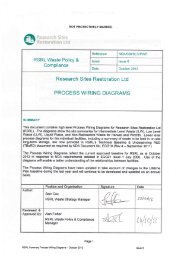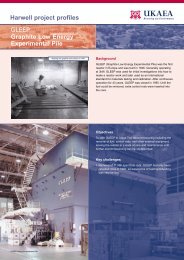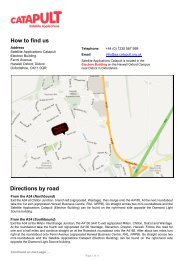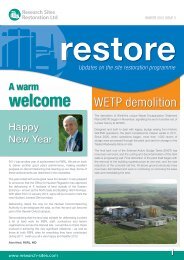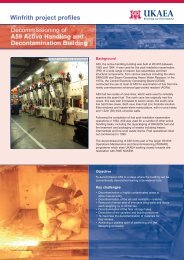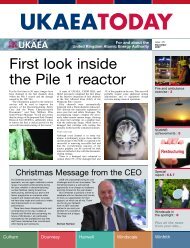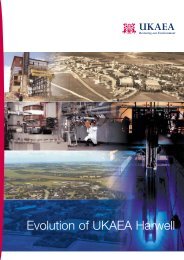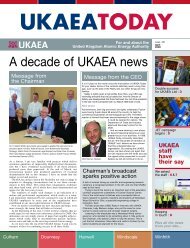RSRL Integrated Waste Strategy - Issue 5- Oct 2012.pdf
RSRL Integrated Waste Strategy - Issue 5- Oct 2012.pdf
RSRL Integrated Waste Strategy - Issue 5- Oct 2012.pdf
You also want an ePaper? Increase the reach of your titles
YUMPU automatically turns print PDFs into web optimized ePapers that Google loves.
NOT PROTECTIVELY MARKED233. Government announced its new policy on low level radioactive waste management inMarch 2007. The policy includes revised regulation around the disposal of LLW to landfilland allows <strong>RSRL</strong> to dispose of high volume very low level waste (up to 4Bq/g except fortritium which is allowed up to 40Bq/g) and LLW (up to 200Bq/g) via this route rather than toLLWR at Drigg (see section 6.1.3.3.)234. GLEEP concrete, which has been stored on the Harwell site for a number of years, hasnow been reused on-site as infill material.6.1.3.1 Disposal to the LLWR near Drigg235. Since a large proportion of the LLW at Harwell is or will be consigned to the LLWR, thestrategy is to minimise the volumes of LLW by application of the waste hierarchy and wasteminimisation using best practicable means. The waste with no option but to be consigned tothe LLWR consists mainly of solid LLW and small volumes of sludges and liquors from thetreatment of low level liquid effluent or trade waste which are converted into a solid beforeconsignment. The recommendation from the site waste BPEO study was to continue withdisposal of this waste to the LLWR near Drigg.236. Low level waste arising on site is either collected in drums for processing or packageddirectly into half height ISO disposal containers (HHISOs). Non-compactable LLW collectedin drums is packaged directly into HHISOs. Compactable waste in drums is sent to theWAste Monitoring And Compaction (WAMAC) Facility at Sellafield or the supercompactorowned by Inutec at Winfrith. Supercompacted pucks are placed in HHISOs and transferredto the LLWR for grouting and disposal. Supercompaction reduces the disposal volume andproduces an improved wasteform.237. Low level liquid, containing higher levels of activity than standard low level liquid effluent,is collected in containers known as carboys. The liquid, together with floc from thetreatment of standard low level liquid effluent, is solidified and conditioned by immobilisationin a lost-paddle cementation plant at the LETP. Drums containing conditioned cementedwaste are placed in HHISOs with other bulk waste and consigned to the LLWR.238. The processing of Low level legacy LETP sludges in the LETP encapsulation plant hasbeen completed and the waste disposed to LLWR. During the retrieval process, one tankwas found to contain sludges in excess of the conditions for acceptance at LLWR andtherefore have been re-categorised as ILW. These sludges have been encapsulated and willremain in interim storage in the Solid <strong>Waste</strong> Complex pending final disposal to the GDF.239. There are a number of drums of stabilised waste arising from the remediation of theWestern Storage Area that contain radioactivity at levels too high to be consigned asexempt (‘out of scope’) hazardous waste. They have been stabilised by solidification incement to produce a monolithic waste form. Initial leach tests have been carried out. Thesewastes are not suitable for disposal to the LLWR however they will be acceptable to thenewly established LA-LLW and HV-VLLW landfill route (see section 6.1.3.3).6.1.3.2 Incineration240. An additional LLW disposal route is incineration at a commercial incinerator with anEPR2010 permit. <strong>Waste</strong>s consigned via this disposal route include low level organic liquidssuch as oils and solvents, which are collected in carboys, filtered and analysed beforetransfer off-site for incineration. The recommendation from the site waste BPEO study wasto continue with incineration of these waste streams.<strong>RSRL</strong> IWS (<strong>Issue</strong> 5 – <strong>Oct</strong>ober 2012)69




